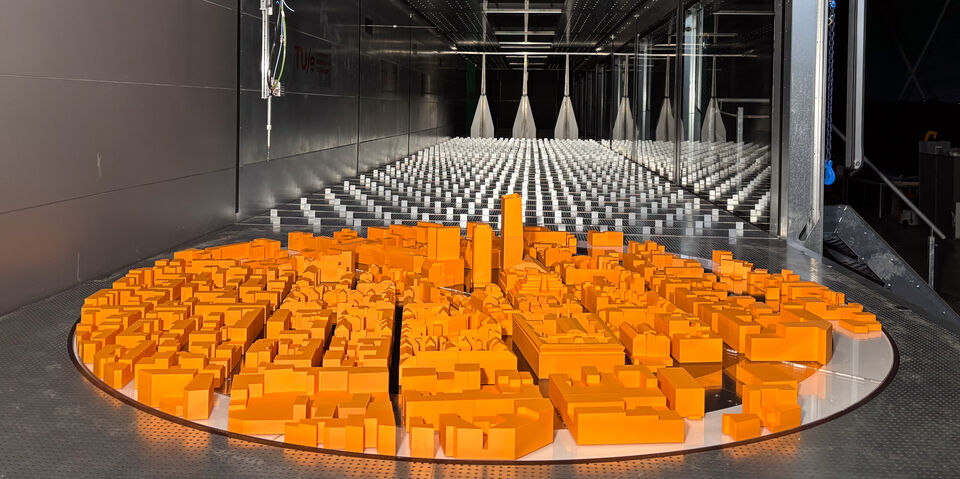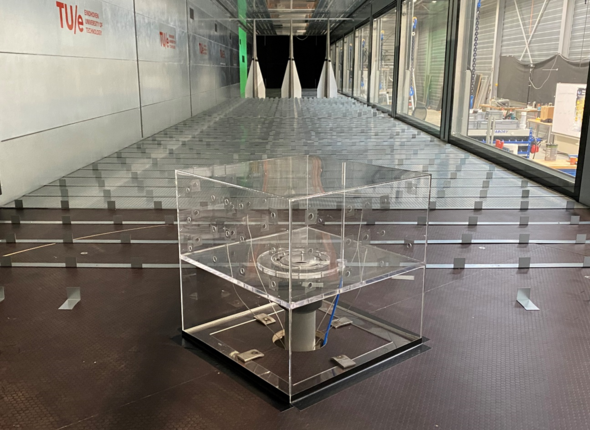Wind tunnel increasingly used for its original purpose
Cyclists pedaling against the wind inside a silver-colored tunnel — for years, that image defined Ventur’s public reputation. Yet the TU/e wind tunnel was originally designed to address architectural and urban challenges. That goal is now being realized more and more.
Inside the hall of the Built Environment wind tunnel, two large-scale city models are ready for testing: one to simulate the dispersion of airborne emissions, and another to study wind speeds at the base of tall buildings. These applications have been envisioned since the tunnel’s opening, but only recently have they really taken off. There are several reasons for that, explains operational manager Stefanie Gillmeier.
Researching airflow within urban environments is more complex to conduct in a wind tunnel than cycling research, she explains. “The most difficult part is to ensure the airflow around the small-scale model behaves the same way as in a real city. The airflow must replicate how the wind behaves just above the earth’s surface.” A long tunnel, such as the one in Eindhoven, is needed to simulate this accurately. By placing floor roughness elements, you can influence the airflow so that it becomes as realistic as possible, Gillmeier explains.
Cyclists
These challenges are not as difficult for research on cyclists. “You don’t need to down-scale cyclists — you can just put them on their bikes in the tunnel,” she says. And because they typically ride at high speeds, all that’s required is a uniform airstream. According to Gillmeier, the cycling research was a relatively easy way to make the tunnel operational quickly. It also brought plenty of media attention, which helped put the facility on the map right away.
Since its launch at the end of 2017, the tunnel has often been used for such projects. As a result, there was less room for studies focusing on urban environments, which require more preparation due to their complexity of model making and down-scaling. The focus of the wind tunnel was already shifting towards architectural and urban applications when professor Bert Blocken – the initiator of both the wind tunnel and the cycling research – left TU/e. His departure and the additional funding coming from a large European research project accelerated that shift.
Wind comfort
“That project really gave us momentum to further enhance the tunnel’s capabilities,” says Gillmeier. “It gave us a clear idea of what measurement equipment, instrumentation, and model making procedures we needed.” Thanks to that support, the tunnel has become much more versatile, as the range of research themes has expanded considerably. Researchers now use it to study, among other things, the wind comfort and safety for pedestrians around tall buildings, the backflow of polluted air through ventilation systems, and the dispersion of air pollution throughout cities.
Ventur is not the only one evolving — Gillmeier’s own career has, too. She started at TU/e as a wind tunnel technician and is since 2022 its operational manager. These days, however, she spends less time in the tunnel itself and more at her desk in Vertigo. “I’m also an assistant professor now. I teach and supervise PhD candidates. I’d like to focus more on the scientific aspects of the tunnel’s work. The projects we’re working on will eventually finish, and new ones need to be developed. Someone has to oversee that process and write new research proposals.” To free up time for that, she’s gradually handing over many of her management responsibilities.
For the time being, the wind tunnel will stay busy with ongoing projects — and the cyclists haven’t completely disappeared either. Several internal and external cycling studies are still in progress, coincidentally also right as Cursor visits, before the interview. Inside the tunnel, a prosthetic leg with a cycling shoe juts into the air. The turbines roar loudly, while up front in the hall, the next city model is already waiting its turn.
This article was translated using AI-assisted tools and reviewed by an editor




Discussion